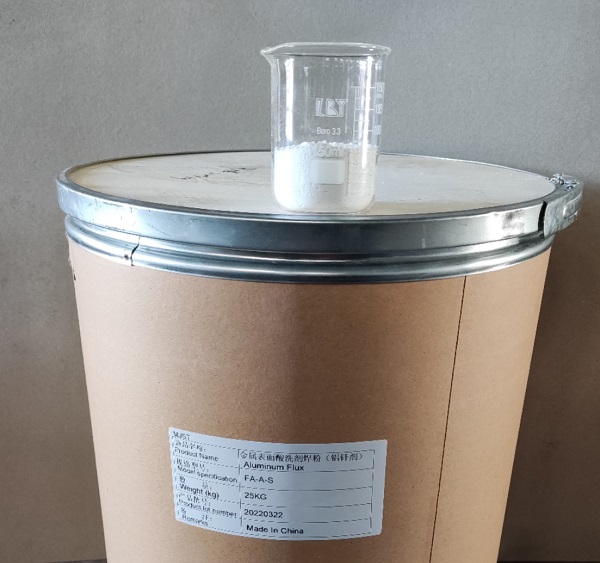

Physical state:
White powder, particle size ≤150um, density: 1.3-1.4 g/cm3
Main ingredients:
Alkali metal and alkaline earth metal chlorides, fluorides, active agents.

When brazing, flux and brazing material can be placed on the area to be welded in advance. Heating simultaneously with the workpiece. During manual flame brazing, the welding wire is first heated and then dipped in flux. Reheat the workpiece to close to the brazing temperature. Then manually feed the welding wire dipped in flux to the area to be welded. Take measures such as using the reductive flame of the porous welding tip to heat the outer flame evenly and avoid directly heating the flux and solder. Prevent oxidation of base material. Make the welding work go smoothly and obtain high-quality welds.
Aluminum use and characteristics of the aluminum flux: It is used to dissolve the oxides on the surface of the aluminum material (mainly remove the Al2O3 on the surface of the aluminum material), and make the solder layer on the metal surface flow capillary and flow freely into the weld.
Preparation before welding: Before welding, the oil stains and oxide films on the surface of the parts should be removed. They can be cleaned in an aqueous solution of 3%-5% Na2CO3 (industrial alkali) and 2%-4% 601 detergent, and then rinsed with clean water. Rinse clean. It should be used within 6-8 hours after cleaning. Do not touch it with your hands or be contaminated with dirt;
Welding operation: During brazing, flux and brazing material can be placed in the place to be welded in advance. Heating simultaneously with the workpiece. During manual flame brazing, the welding wire is first heated and then dipped in flux. Reheat the workpiece to close to the brazing temperature. Then manually feed the welding wire dipped in flux to the area to be welded. Take measures such as using the reductive flame of the porous welding tip to heat the outer flame evenly and avoid directly heating the flux and solder. Prevent oxidation of base material. Make the welding work go smoothly and obtain high-quality welds. ;
Post-weld treatment: The post-weld residue of corrosive aluminum flux has a strong corrosive effect on the base metal and should be cleaned up in time.
1. Can be soaked in water at 50-60℃ and then scrubbed carefully.
2. For workpieces with complex structures, after the solder is solidified, the weldment can be plunged into water while it is hot and quenched. The explosion of vaporized water molecules will cause the residue to crack and fall off due to the rapid cooling.
The soluble part also dissolves at the same time. However, the temperature of the weldment should not be too high when it is put into water to avoid deformation or cracking of the weldment.
3. Dip into an aqueous solution of 30 g/L oxalic acid, 15 g/L sodium fluoride, and 30 g/L 601 detergent, keeping the temperature at 70-80°C.
4. Dip the aqueous solution of 5% phosphoric acid and 1% chromic anhydride by volume at 82°C.
5. After soaking in hot water. Then immerse in 10% nitric acid and 0-25% hydrofluoric acid for 2-3 minutes.